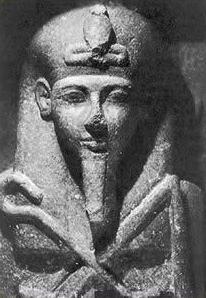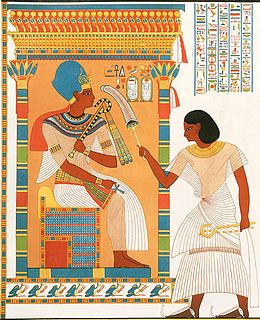
Seti II was the fifth pharaoh of the Nineteenth Dynasty of Egypt and reigned from c. 1203 BC to 1197 BC. His throne name, Userkheperure Setepenre, means "Powerful are the manifestations of Re, the chosen one of Re." He was the son of Merneptah and Isetnofret II and sat on the throne during a period known for dynastic intrigue and short reigns, and his rule was no different. Seti II had to deal with many serious plots, most significantly the accession of a rival king named Amenmesse, possibly a half brother, who seized control over Thebes and Nubia in Upper Egypt during his second to fourth regnal years.

Amenmesse was the fifth pharaoh of the Nineteenth Dynasty in Ancient Egypt, possibly the son of Merneptah and Queen Takhat. Others consider him to be one of the innumerable sons of Ramesses II. Very little is known about this pharaoh, who ruled Egypt for only three to four years. Various Egyptologists date his reign between 1202 BC–1199 BC or 1203 BC–1200 BC with others giving an accession date of 1200 BC. Amenmesse means "born of or fashioned by Amun" in Egyptian. Additionally, his nomen can be found with the epithet Heqa-waset, which means "Ruler of Thebes". His royal name was Menmire Setepenre.
The former Kingdom of Kerma in Nubia, was a province of ancient Egypt from the 16th century BCE to eleventh century BCE. During this period, the polity was ruled by a viceroy who reported directly to the Egyptian Pharaoh. It is believed that the Egyptian 25th Dynasty were descendants of these viceroys, and so were the dynasties that ruled independent Kush until the fourth century CE.

Bay, also called Ramesse Khamenteru, was an important Asiatic official in ancient Egypt, who rose to prominence and high office under Seti II Userkheperure Setepenre and later became an influential powerbroker in the closing stages of the 19th Dynasty. He was generally identified with Irsu mentioned in the Great Harris Papyrus, although no contemporary source connects Bay with Irsu.

Akhenre Setepenre Siptah or Merenptah Siptah was the penultimate ruler of the Nineteenth Dynasty of Egypt. His father's identity is currently unknown. Both Seti II and Amenmesse have been suggested although the fact that Siptah later changed his royal name or nomen to Merneptah Siptah after his Year 2 suggests rather that his father was Merneptah. If correct, this would make Siptah and Seti II half-brothers since both of them were sons of Merneptah.

The Temple of Amada, the oldest Egyptian temple in Nubia, was first constructed by Pharaoh Thutmose III of the 18th dynasty and dedicated to Amun and Re-Horakhty. His son and successor, Amenhotep II continued the decoration program for this structure. Amenhotep II's successor, Thutmose IV decided to place a roof over its forecourt and transform it into a pillared or hypostyle hall. During the Amarna period, Akhenaten had the name Amun destroyed throughout the temple but this was later restored by Seti I of Egypt's 19th Dynasty. Various 19th Dynasty kings especially Seti I and Ramesses II also "carried out minor restorations and added to the temple's decoration." The stelas of the Viceroys of Kush Setau, Heqanakht and Messuy and that of Chancellor Bay describe their building activities under Ramesses II, Merneptah and Siptah respectively. In the medieval period the temple was converted into a church.
Ahmose called Turo was Viceroy of Kush under Amenhotep I and Thutmose I.

Merymose, also Mermose or Merimes, was a Viceroy of Kush under Amenhotep III. He served for almost the entire four decades of that reign.

Amenhotep called Huy was Viceroy of Kush under Tutankhamen. He was the successor of Tuthmosis, who served under Akhenaten. He would later be succeeded by Paser I.

Amenemopet served as Viceroy of Kush during the reign of Seti I.
Heqanakht was Viceroy of Kush during the reign of Ramesses II. His titles include: King's son of Kush, overseer of the Southern Lands, Fan-bearer on the Right Side of the King, Messenger to every land, Hereditary prince, royal sealbearer.
in Ancient Egypt, Paser II was the son of the High Priest of Min and Isis named Minmose. Paser came from a very well-connected family. One uncle was the High Priest of Amun Wennenefer and another uncle was the troop commander of Kush named Pennesuttawy. Through Wennenefer, Paser was related to Amenemone, Amenemope and Hori, the High Priest of Anhur.
Paser I was the Viceroy of Kush during the reigns of Ay and likely Horemheb. Reisner mentions that the only datable inscriptions for Paser belong to the reign of Ay. The next known Viceroy however is Amenemopet, who is dated to the reign of Seti I. Hence it's possible that Paser I served during the reigns of Ay, Horemheb.
Tuthmose was the Viceroy of Kush during the reign of Akhenaten. Tuthmose was given the titles King's Son of Kush, Overseer of the Gold Lands of Amun, Overseer of masons, Overseer of the borderlands of His Majesty, and Fan-bearer on the King's right.
Hori I, son of Kama, was Viceroy of Kush under Siptah and is attested in year 6 of that king. He likely continued to serve under Twosret, Setnakhte, and Ramesses III. Hori's titles include: King's Son of Kush, First charioteer of His Majesty, and King's messenger to every land. Hori I was succeeded by his son who was also called Hori.
Hori II is a son of Hori I and also served as Viceroy of Kush. Their tombs have been found in Tell Basta. Hori II may have been the father of a later Viceroy named Wentawat.

Wentawat, was Viceroy of Kush under Ramesses IX, during the 20th Dynasty. He was a son of the Viceroy Nahihor.
This page list topics related to ancient Egypt.

The Theban Tomb TT383 is located in Qurnet Murai, part of the Theban Necropolis, on the west bank of the Nile, opposite to Luxor. It is the burial place of the ancient Egyptian Viceroy of Kush named Merymose, who lived during the 18th Dynasty and served under Amenhotep III.

Yuni served as Head of the-stable-of-Seti-I, Charioteer of His Majesty, and Chief of the Medjay before becoming Viceroy during the reign of Seti I. He would use some of these titles simultaneously. On a stela from Abydos – now in the Cairo Museum – the inscription reads:
Made by the Superintendent of Deserts in the Southern Foreign country, Viceroy in Nubia (Ta-Sety), Chief of Works in the Estate of Amun, Chief of the Madjayu-militia, Iuny. (Kitchen)











